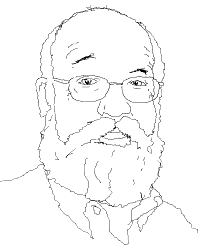 Kristinn R. Thorisson wants artificial intelligence to build itself. Thorisson was the creator of Gandalf*, the ‘communicative humanoid’ who was designed in a way that amply disproved Frank Zappa’s remark:
Kristinn R. Thorisson wants artificial intelligence to build itself. Thorisson was the creator of Gandalf*, the ‘communicative humanoid’ who was designed in a way that amply disproved Frank Zappa’s remark:
“The computer … can give you the exact mathematical design, but what’s missing is the eyebrows.”
Thorisson proposes that constructionism must give way to constructivism (pdf) if significant further progress towards artificial general intelligence is to be made. By constructionism, he means a traditional ‘divide and conquer’ approach in which the overall challenge is subdivided, modules for specific tasks are more or less hand-coded and then the results are bolted together. This kind of approach, he says, typically results in software whose scope is limited, which suffers from brittleness of performance, and which integrates poorly with other modules. Yet we know that a key feature of general intelligence, and particularly of such features as global attention is a high level of very efficient integration, with different systems sharing heterogeneous data to produce responsive and smoothly coordinated action.
Thorisson considers some attempts to achieve better real-world performance through enhanced integration, including his own, and acknowledges that a lot has been achieved. Moreover, it is possible to extend these approaches further and achieve more: but the underlying problems remain and in some cases get worse: a large amount of work goes into producing systems which may perform impressively but lack flexibility and the capacity for ‘cognitive growth’. At best, further pursuit of this line is likely to produce improvements on a linear scale and “Even if we keep at it for centuries… basic limitations are likely to asymptotically bring us to a grinding halt in the not-too-distant future.”
It follows that a new approach is needed and he proposes that it will be based on self-generated code and self-organising architectures. Thorisson calls this ‘constructivism’, which is perhaps not an ideal choice of name, since there are several different constructivisms in different fields already. He does not provide a detailed recipe for constructivist projects, but mentions a number of features he thinks are likely to be important. The first, interestingly, is temporal grounding – he remarks that in contrast to computational systems, time appears to be integral to the operation of all examples of natural intelligence. The second is feedback loops (but aren’t they a basic feature of every AI system?); then we have Pan-Architectural Pattern Matching, Small White-Box Components (White-Box as opposed to Black-Box, ie simple modules whose function is not hidden), and Architecture Meta-Programming and Integration.
Whether or not he’s exactly right about the way forward, Kristinsson’s criticisms of traditional approaches seem persuasive, the more so as he has been an exponent of them himself. They also raise some deeper questions which, as a practical man, he is not concerned with. One issue, indeed, is whether we’re dealing here with difficulties in practice or difficulties in principle. Is it just that building a big AGI is extremely complex, and hence in practice just beyond the scope of the resources we can reasonably expect to deploy on a traditional basis? Or is it that there is some principled problem which means that an AGI can never be built by putting together pre-designed modules?
On the face of it, it seems plausible that the problem is one of practice rather than principle, and is simply a matter of the huge complexity of the task. After all, we know that the human brain, the only example we have of successful general intelligence, is immensely complex, and that it has quirky connections between different areas. This is one occasion when Nature seems to have been indifferent to the principles of good, legible design; but perhaps ‘spaghetti code’ and a fuzzy allocation of functions is the only way this particular job can be done; if so, it’s only to be expected that the sheer complexity of the design is going to defeat any direct attempt to build something similar.
Or we could look at it this way. Suppose constructivism succeeds, and builds a satisfactory AGI. Then we can see that in principle it was perfectly possible to build that particular AGI by hand, if only we’d been able to work out the details. Working out the details may have proved to be way beyond us, but there the thing is: there’s no magic that says it couldn’t have been put together by other methods.
Or is there? Could it be that there is something about the internal working of an AGI which requires a particular dynamic balance, or an interlocking state of several modules, that can’t be set up directly but only approached through a particular construction sequence – one that amounts to it growing itself? Is there after all a problem in principle?
I must admit I can’t see any particular reason for thinking that’s the way things are, except that if it were so, it offers an attractive naturalistic explanation of how human consciousness might be, as it were, gratuitous: not attributable to any prior design or program, and hence in one sense the furthest back we can push explanation of human thoughts and actions. If that’s true, it in turn provides a justification for our everyday assumption that we have agency and a form of free will. I can’t help finding that attractive; perhaps if the constructivist approaches Thorisson has in mind are successful this will become clearer in the next few years.
* For anyone worried about the helmet, I should explain that this Gandalf was based on a dwarf from Icelandic cosmogony, not Tolkien’s wizard of the same name.

 Daniel Dennett not sceptical enough about qualia? It seems unlikely. Dennett’s trenchant view can be summed up in two words: ‘What qualia?”. It makes no sense, he would say, for us to talk about ineffable items of direct experience: things which by their definition, we can’t talk about. That’s not to say we can’t talk about our experience of the world: we just need to talk about it in third-person, heterophenomenological terms. Instead of claiming to discuss people’s first-person inner experience, we discuss what they report about their first-person inner experience. In fact, if we think about it carefully, we’ll realise that’s all we could ever do, all we’ve ever done: really, whatever we may have supposed, all phenomenology is actually heterophenomenology; all discussion is necessarily in third-person, objective, scrutable, effable terms.
Daniel Dennett not sceptical enough about qualia? It seems unlikely. Dennett’s trenchant view can be summed up in two words: ‘What qualia?”. It makes no sense, he would say, for us to talk about ineffable items of direct experience: things which by their definition, we can’t talk about. That’s not to say we can’t talk about our experience of the world: we just need to talk about it in third-person, heterophenomenological terms. Instead of claiming to discuss people’s first-person inner experience, we discuss what they report about their first-person inner experience. In fact, if we think about it carefully, we’ll realise that’s all we could ever do, all we’ve ever done: really, whatever we may have supposed, all phenomenology is actually heterophenomenology; all discussion is necessarily in third-person, objective, scrutable, effable terms. Paul Almond’s Attempt to Generalize AI has reached Part 8:
Paul Almond’s Attempt to Generalize AI has reached Part 8: